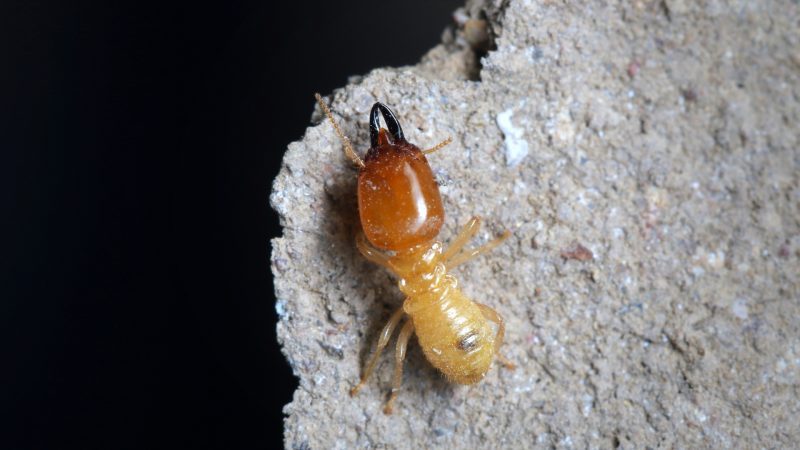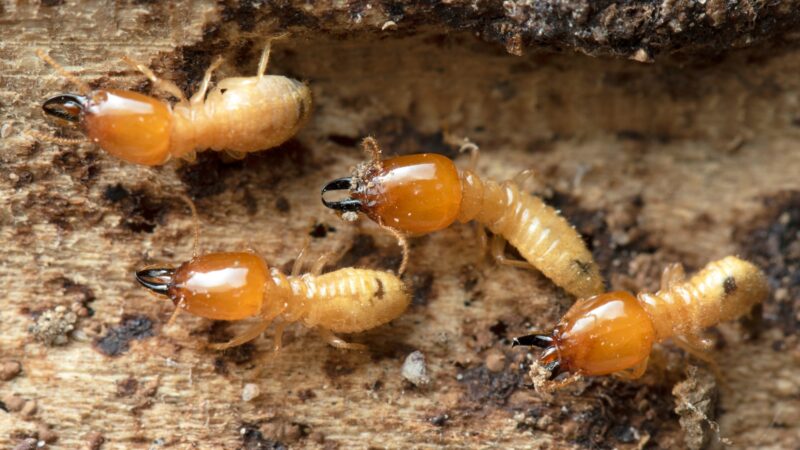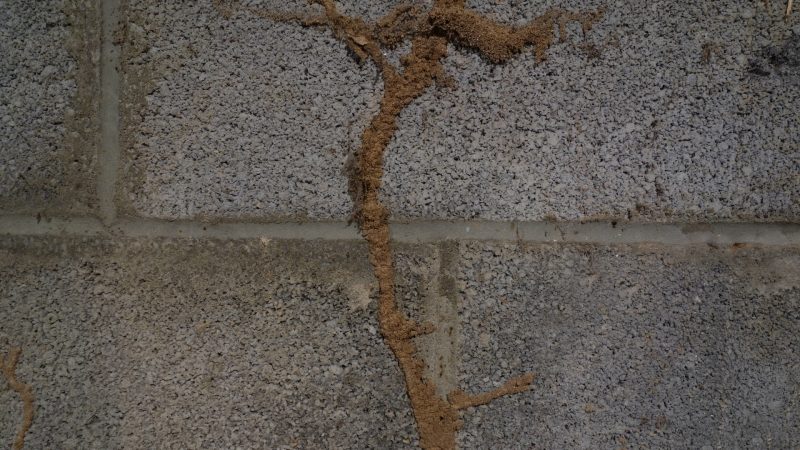Subterranean termites are insects that live in colonies. They can cause significant damage to any structure and can even cause structural collapse.
How do you get rid of subterranean termites? You can get rid of these termites by treating your wood, spraying them with chemicals, and creating a chemical barrier in the soil. Use liquid repellent or bait and target the entire colony of these termites. When infestation is severe, consider fumigating your home for termite control.
However, this is easier said than done. Each termite control method involves several processes that need to be followed to succeed. So, if you want to get rid of subterranean termites effectively, you may read the extensive details below.
What Are Subterranean Termites?

| Name | Family | Average Length | Color | Shape |
| Subterranean Termites | Rhinotermitidae | ⅛ inch long | Creamy white to dark brown/black | Long, narrow, and oval |
As discussed above, subterranean termites are social insects that can cause serious damage to your home or any structure. This is because they can target the beams, insulation, sub-flooring, plastic plumbing pipes, and the foundation of your home.
These insects can also cause harm to your shrubs and trees, as they sometimes feed on them, killing your plants eventually. Aside from that, they can build peculiar tunnels known as ‘mud tubes’ to get food sources and protect themselves from the open.
Typically, they nibble on wood 24 hours a day, resulting in a collapse if not prevented. These termites are one of the greatest threats to every homeowner across every state in the United States except Alaska.
Termites aren’t fond of the cold climates, that Alaska has. Thus, finding termites in this state is almost impossible.
Types of Subterranean Termites
There are three different types of subterranean termites—the reproductives (king, queen, alates), workers, and soldiers. They have separate obligations, which contribute to the colony’s growth as a whole.
King & Queen Termites
In the termite family, the queen is the largest, and the king is a bit smaller. The queen is responsible for laying eggs and maintaining the colony’s growth along with the king.
Both the queen and king can live up to a decade. Nonetheless, in terms of size, the queen size is much bigger than the king. A king termite can grow only 1/2 inch, while the queen can grow up to 4 to 6 inches.
Alates
Alates are termites that have wings. They’re part of the reproductives, which include the king and queen termites.
Alates are produced by the king and queen termites several times a year. These termites are sexually mature males and females that eventually leave their own nests to start new colonies.
You can identify alates with their pale brown or grey wings. They’re about 1/4 to 1/2 of an inch long and can live up to 4 years.
Soldier Termites
Just the name itself, it’s clear that the soldier termites are responsible for the safety of the nest. Their job is to defend their nest from their enemies, which are typically ants.
These creatures have large heads and jawbones. They’re practically equipped for every battle that comes their way.
You can also identify the termite soldiers with their elongated pale red, white, or brown bodies. Their length is between 1/4 and 1/2 of an inch, and they can live up to two years.
Worker Termites
The worker termites’ primary responsibility is to feed their queen and termite soldiers. To keep their colony alive, they’re the ones responsible for storing and maintaining food.
They’re the ‘all-around house helper,’ taking care of the immature termites and maintaining the colony itself. These termites are white or pale and have straight antennae with rounded heads and bodies.
They can last up to two years, and their bodies are about 1/8 to 3/8 of an inch.
Subterranean Termite Colony

The typical subterranean termite colony can have about 60,000 to 2 million workers. This is why you have to take prompt action when you spot a group of termites in your home.
They can grow immensely and create significant damage to your property. Their scissor-like jaws are used to eat wood for 24 hours a day.
Even a colony of 60,000 workers is enough to cause significant damage to your property. With the given number of workers, these are enough to devour, 2.3 feet of a 2×4 wood board in a year.
These termites can collapse an entire building over time and cause homeowners to be problematic financially. Thus, if you spot any termites within your property, make sure to take action right away before it gets worse.
Letting termite issues slide for another day means extra damage that can cost you a fortune.
How Do Subterranean Termites Live?
Subterranean termites live by eating wood 24 hours and other products that have cellulose, such as:
- Papers
- Books
- Boxes
- Drywall
- Furniture
- Carpet backing and more
What Do Subterranean Termites Look Like?

Eastern Subterranean Termite
The Eastern subterranean termite has a milky, yellowish-white appearance. In terms of length, the worker termite is about 1/8 of an inch.
Meanwhile, the soldier termite has a length between 1/4 and 1/2 of an inch. They have large, pincer-like jawbones and their heads are rectangular.
Swarmers (part of reproductives), can grow as long as 3/8 of an inch. They’re dark brown to blackish.
Western Subterranean Termites
The Western subterranean termites have the same appearance as swarmers of eastern subterranean termites. Worker termites are white or cream in color, whereas soldiers have an orange, rectangular head.
On the other hand, the swarmers are dark brown and about 3/8 of an inch in length. They have two pairs of wings, being the front wings larger than the hind wings.
Formosan Subterranean Termite
The Formosan subterranean termites are species classified by their large populations. They’re about 0.25 to 0.5 of an inch and can be found in the connecting soil and infested house.
Just like other termite species, they also have primary castes, inclusive of reproductives (king, queen, alates), soldiers, and workers.
Formosan Subterranean Termite Habitat
The Formosan termites are typically found in dark, damp areas that aren’t exposed to air. These termites require moisture to survive and can also be found in the following:
- Dead logs
- Tree stumps
- Soil
- Dry wood structures
These termites are also widely present across Alabama, North Carolina, Hawaii, Louisiana, and more.
Drywood Termites
Drywood termites aren’t the type that needs some moisture to survive. These termites choose to live in a home where wood is abundant and where they can start a new colony.
They can typically be found in attics, infesting structural wood. Apart from the structural structures, they also infest the following:
- Dead trees
- Shrubs
- Furniture
- Utility poles
- Fences
Subterranean Termites vs. Drywood Termites
When it comes to wing differences, subterranean termites (alates) have only a single thick and dark vein that runs to the top of their wings. Meanwhile, dry wood termites have a complex veins system.
Apart from that, the subterranean termites live in the ground while the drywood termites live inside the wood they’re infesting. The subterranean also need soil to survive, while the dry-wood termites don’t.
Formosan Termites vs. Subterranean Termites
Compared to the subterranean termites, the Formosan termites have longer bodies and shorter heads. They’re translucent orange in color, while the subterranean termites have a gray/brown translucent color.
What Do Subterranean Termite Droppings Look Like?
The subterranean termite droppings are tiny, oval-shaped pellets. Their color ranges from light beige to black, depending on the wood type the termites are eating.
These pellets or droppings can form small piles below wood holes, resembling small mounds of dirt, sawdust, or pepper. To ensure that their nests are not poop-free, these termites intentionally make tiny holes in wood.
Related: Termite Droppings: Differences Between Termite Poop and Sawdust
What to Do When You Find Termite Droppings?
If you see these droppings, it affirms the presence of termites in your home. Thus, it’s best to start inspecting the site right away where the pellets are found and look further to see the magnitude of termite activities in your house.
If you notice the infestation is at its worst state, make sure to call a pest control professional right away. They can help you eliminate termites in your property fast and in a safe manner.
How to Identify a Termite Infestation?

Start by inspecting the cracks in your home and your attic. Here are some different sorts of proof that the foundation of your house is being attacked.
- Hollow wood
- Strange sounds in your walls
- Seeing mud tubes
- Difficult to open windows and doors
- Seeing live termites
Subterranean Termite Treatment
There are various ways to get rid of subterranean termites. You can treat your woods with chemicals, make a chemical barrier in the soil, and use bait or fumigation in case of severe infestation. To kill these termites naturally, you may also try DIY termite treatment.
The following are some of the subterranean termite treatments you can use to eradicate your termite problems.
Treat Your Woods With Chemicals
Treating your woods with chemicals like copper azole can help deter these pests from consuming your woods. This treatment can also strengthen your wood, making it less vulnerable to termite consumption.
- EPA-registered, insecticidal preservative prohibits termite...
- Inhibits surface growth of fungal organisms: mold, mildew and...
- Paintable and stainable; imparts a transparent green color that...
Use Liquid Chemicals Spray
Another option you have is to spray liquid chemicals on your wood. However, this method will only protect particular spots of your wood, not the entirety of it.
Make a Chemical Barrier in the Soil Around Your Home
Creating a chemical barrier around your home can also hinder termites from gaining access to your house. You can use liquid insecticide like Compare-N-Save 7.9% Bifenthrin Concentrate .
- For use indoors and outdoors
- Can be tank mixed with other pesticides, including insect growth...
- Controls indoor pests including fleas, cockroaches and ants
- Also controls insects on ornamentals, trees and shrubs
- Covers up to 44,000 sq. ft.; Makes up to 44 gal. of ready-to-use...
Bifen contains active ingredients of 7.9% bifenthrin, which is a mixture of insecticide and termiticide. You can spray this on the soil beneath the foundation of your home.
A quart of this concentrated liquid insecticide can yield 44 gallons and lasts up to three months.
Use of Baits
Another way to bait the entire colony of these termites is through the use of baits . This method has risen in popularity as a way to handle an infestation.
- Two termite products IN one: pop-up indicators detect termite...
- Installs IN minutes: place stakes in the ground 2 to 3 feet away...
- Pop-up indicator: check the stakes for termite activity when the...
- Complete kit: includes 15 stakes with locator shields,...
The method involves slow-acting insecticides that are consumed by the termites and brought to their nest, where the chemicals spread out to a broad termite colony.
Some baits utilize Insect Growth Regulators (IGRs), which are highly efficient in killing the entire termite colonies. These IGRs contain low toxicity, which means they’re not of high risk to humans and pets.
Fumigation
If the termite’s infestation is at its worst state, consider the fumigation method. Fumigation is the process of using chemical smoke to eliminate your subterranean termite problems.
This method is best used by professional pest control and is not a do-it-yourself type of method.
For several products and DIY methods, you may refer to the following guide below. Nonetheless, bear in mind that these ways only work for a less serious termite infestation.
Thus, it would still be best to call your local pest control expert to assess your termite situation.
DIY Subterranean Termite Treatment
For DIY subterranean termite treatment, you may use liquid barrier termite treatments. These are usually applied to the soil surrounding your house, near the foundation of your home.
This blocks all potential routes of termite entry. Any termites venturing into the treated soil were either killed or deterred.
Subterranean Termite Control Products
Fipronil
- Easy to Apply Solution: Ready-to-use foam formulation with...
- Powerful Active Ingredient: Non-repellent termiticide,...
- Versatile Application: Effectively treats wall voids, wooden...
- Targets Multiple Pests: Eliminates termites including arboreal,...
- Safety First: Read, understand, and follow the label safety,...
Fipronil is a commonly used insecticide that’s part of the phenylpyrazole chemical. This white powder insecticide has a moldy odor that’s also effective in controlling the following:
- Ants
- Cockroaches
- Fleas
- Ticks
In using Fipronil, you’re going to need any of the following:
- Hand-held pump sprayer
- Backpack sprayer
- Professional spraying rig (large volume applications)
The ideal ratio for this termiticide is 0.8 fl. oz. of Termidor per gallon of water for a 0.06% dilution ratio. For one gallon of Fipronil dilution, you can treat around 1,000 square feet of area.
Fill your spray bottle with 1/4 water and add 0.8 fl. oz. of Termidor to the sprayer for exterior use. Make sure to shake the solution before using it to ensure an even mix.
Note: There are various products brands of Finopril. Thus, it’s crucial to read the label for their instructions. Make sure to follow all the instructions given by the manufacturer to ensure safe and effective use.
Chlorfenapyr
- Total Release Pest Control: Greenhouse aerosol fogger kills...
- Active Ingredient: Contains chlorfenapyr 4.5%; pyrrole class...
- Greenhouse Application Only: For use in enclosed growing areas...
- Target Insects: Controls thrips, spider mites, aphids,...
- Safety First: Read, understand, and follow the label safety,...
This termite control product is a pesticide that’s metabolized and turns into an active insecticide once it enters the body of termites. The chemical is procured from the halogenated pyrroles— which are microbially produced compounds.
Step 1: Prepare 0.125% dilution by mixing 75 fluid ounces of Chlorfenapyr active ingredients with 99.4 gallons of water.
Step 2: Mix the dilution by filling the tank with 1/4 to 1/3 full of water. The filling hose should have an anti-backflow device to protect against back siphoning.
Step 3: Start to pump to bypass agitation and put the end of the treating tool in the tank. This is to enable circulation through the hose.
Step 4: Add the appropriate amount of Chlorfenapyr. Then, add the remaining water to the tank.
Step 5: Let the pump run for about two to three minutes for circulation and start spraying after the given time.
Remember to always read the label of the product you’re using to ensure efficacy and safety.
Imidacloprid
- Protect plants from insect damage with Systemic Granules for...
- Protection lasts for up to 8 weeks after application; the...
- Product kills insects such as mealybug, aphids, scale, and more...
- Systemic Insect Control Granules are not intended for use on...
- This product arrives conveniently ready-to-use; to use apply...
Imidacloprid is a type of insecticide produced to copy nicotine. Nicotine is typically found in various plants like tobacco, which is considered toxic for insects.
Aside from the subterranean termites, this insecticide is also used in managing the following:
- Soil insects (cockroaches, crickets, earwigs, scarabs, Symphyla, wireworms)
- Fleas on pets
- Sucking insects (aphids, leafhoppers, thrips, whitefly, flies, bugs, and mites)
In general, you’ll need 0.46 to 0.6 fl. oz. in a gallon of water per 1,000 sq to effectively wipe out your termite problem. Put the required amount of mixture in a spray tank and spray it on the affected areas.
How to Kill Subterranean Termites Naturally?

To kill the subterranean termites naturally, you may consider using the following products below:
Borates
Borates are sold as a borax powder. They’re not only used to wash your laundry but also kill the termites in your home.
For application, apply the powder to the affected area or mix it with water. You may also spray it on the areas that you believe are infested.
Vinegar
Another product that you can use to kill termites naturally is vinegar. This product isn’t only best to disinfect your kitchen counter but also terminate termites.
Mix a half cup of vinegar with two lemon juice, and you’ve got your solution. Put the solution into a spray bottle and spray it on the infected area.
The acidity of the two combined ingredients is enough to kill the termites that come in contact with the solution. Furthermore, ensure to spray the suspected area regularly to make sure to catch the termites that weren’t there in your last application.
Orange Oil
Another product that you can use to kill termites naturally is Orange oil . The oil is procured from the peels of oranges, which are deadly to termites.
- Certified Organic Orange Oil - Cliganic organic essential oils...
- 100% Pure, Single Ingredient Oil - Cliganic organic essential...
- Multipurpose Essential Oil – Cliganic essential oils are...
- 3rd Party Tested for Purity - Each batch is being tested for...
- Non-GMO Certified, Vegan & Cruelty-Free - Free from additives,...
You can buy this product online, as well as in garden and home improvement stores. For application, you can spray it directly to the termites or the suspected area of infestation.
The orange oil can dissolve the exoskeletons of termites, resulting in losing their proteins and moisture, leaving them to die.
Frequently Asked Questions
Do Subterranean Termites Bite Humans?
Termites aren’t known to bite humans. They only bite wood and attack other insects they consider rivals.
How Serious Are Subterranean Termites?
Subterranean termites should be taken seriously, as they’re reported to cause billions of dollars in structural damage per year. Aside from structural damages, they can also damage your books and other paper products.
They’re also known to eat cellulose-based products and diverse plant goods.
Does Fumigation Kill Subterranean Termites?
Not all subterranean termites will get killed in the fumigation. There’s a need for separate treatment to make a barrier between the structure and their den in the ground.
However, under favorable conditions, the targeted pests will be dead at the end of the fumigation process.
Will Borax Kill Subterranean Termites?
Borax can kill subterranean termites once they ingest this substance. All you have to do is mix one teaspoon of borax acid with one cup of warm water in a clean bottle spray.
- Made from anhydrous pure powdered sodium borate with no additives...
- Use as a cleansing booster with your laundry or dish detergent or...
- Borax can be used for a variety of things from rust remover to...
- Non-perishable: Packaged in resealable bag to preserve freshness....
- Odorless, opaque white powder. Available in 1 lb., 2 lb., 5 lb.,...
Make sure to shake the solution gently until the powder is dissolved. After that, soak the infected areas by spraying the solution.
Repeat this for three to five consecutive days and examine your home for further signs of termite damage or presence.
Can Subterranean Termites Come Back After Treatment?
Subterranean termites are highly capable of coming back after the treatment. This is why there’s a need for ongoing pest control maintenance.
If you opt to hire pest control professionals, they can help you create a barrier. This barrier could deter these termites from returning to your home after being fully treated.
List of Sources
Lewis, V. R., Sutherland, A. M., Haverty, M. I. (2014). Subterranean and Other Termites. University of California.
Potter, M. F. (2018). Termite Baits: A Guide for Homeowners. University of Kentucky.
Overview of Wood Preservative Chemicals. United States Environmental Protection Agency.
- What Does Termite Damage Look Like? | Information and Facts - October 8, 2022
- Are White Ants and Termites the Same? | All You Need to Know! - October 9, 2021
- How to Get Rid of Subterranean Termites | Effective DIY Techniques - September 8, 2021









